Sphinx poecila, the Poecila Sphinx
Sphinx poecila
Sfinksmmpoh-SYE-luh
Poecila Sphinx
Stephens, 1828
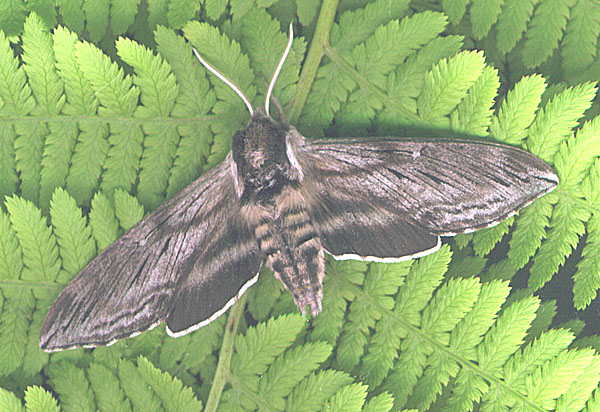
Sphinx poecila by Bill Oehlke
This site has been created by
Bill Oehlke at oehlkew@islandtelecom.com
Comments, suggestions and/or additional information are welcomed by Bill.
TAXONOMY:
Family: Sphingidae, Latreille, 1802
Subfamily: Sphinginae, Latreille, 1802
Tribe: Sphingini, Latreille, 1802
Genus: Sphinx (Linnaeus, 1758)
Species: gordius (Cramer 1780)
Subspecies: poecila (Stephens, 1828)........
|
MIDI MUSIC
......It's a Wonderful World......
copyright C. Odenkirk
ON.OFF
<bgsound src="world.mid" LOOP=FOREVER>
|
DISTRIBUTION:
Sphinx poecila, the Poecila Sphinx
(Wing span: 2 11/16 - 3 3/4 inches (6.8 - 9.5 cm)),
is a northern species found in boggy areas, coastal barrens, and
deciduous forests in Newfoundland, Prince Edward Island and Nova
Scotia (healthy populations in Sheet Harbour) and southward of those
provinces from Maine to Pennsylvania and westward to Michigan,
northeastern Illinois, and Wisconsin.
Specimens have also been taken in Canada as far west as Alberta.
Tim Andrews sends this image of a larvae found in the
Northwest Territories.
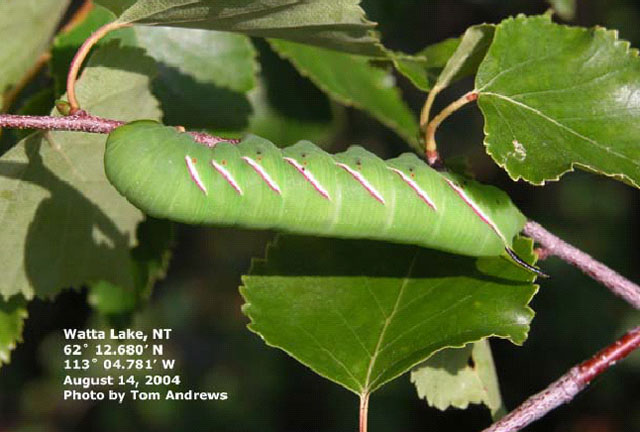
Sphinx poecila
courtesy of Tom Andrews, via David Tilden.
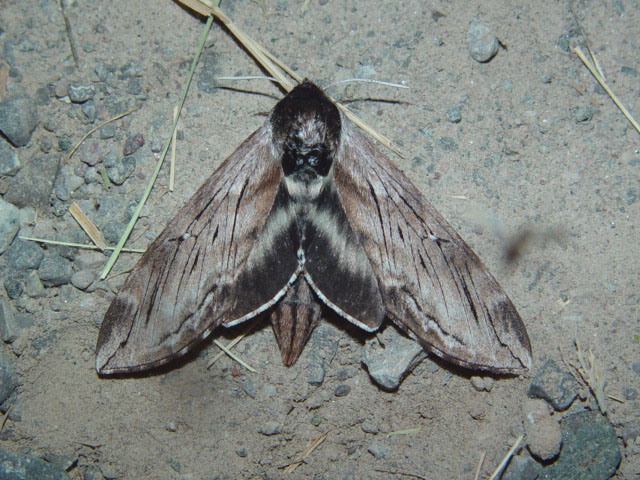
Sphinx poecila, June 30, Peterborough, Ontario, courtesy of Tim Dyson.
The outer wing fringes are checkered black and white on the forewing,
and are almost pure white (lightly checked with grey) on the hindwing. The forewing is dark gray with diffuse black and gray wavy lines with a
series of black dashes ending at the wing tip, and a white cell spot.
The white cell spot readily distinguishes poecila from canadensis.
The hindwing is brownish gray with a wide black border and a black
median line.
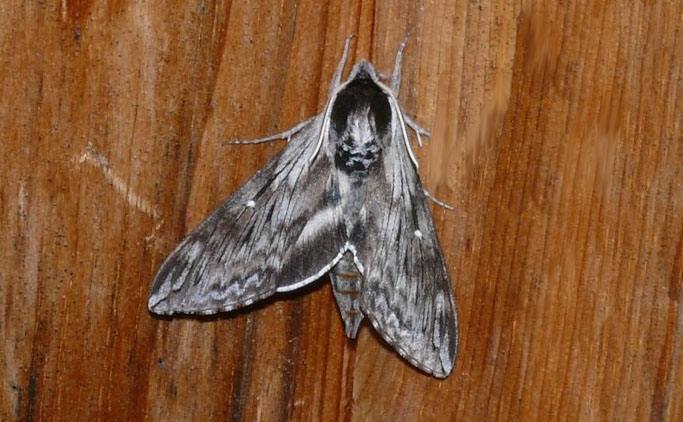
Sphinx poecila, Athol, Worcester, Massacusetts,
June 26, 2008, courtesy of Dave Small.
FLIGHT TIMES:
Sphinx poecila is single-brooded
throughout its range with moths on the wing from May-September.
ECLOSION:
Sphingidae pupae wiggle to the soil surface from their underground chambers
just prior to eclosion.
SCENTING AND MATING:
Sphinx poecila moths nectar
from flowers including dogbane (Apocynum),
honeysuckle (Lonicera), lilac (Syringa), evening primrose (Onagraceae),
bouncing bet (Saponaria officinalis), and phlox (Phlox). Pairing is for a brief time and males
come in to lights much more readily than females who are busy
ovipositing and feeding.
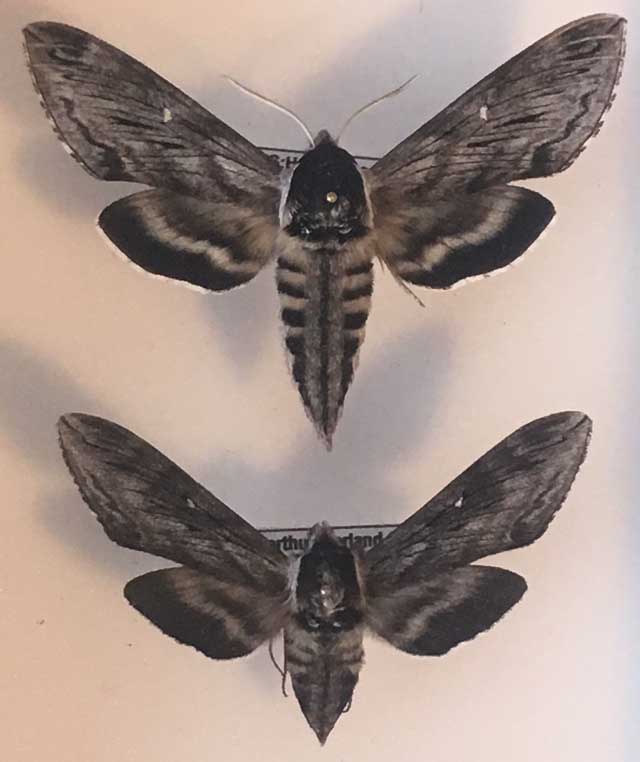
Sphinx poecila, Renoir-Quarryville, Northumberland County, New Brunswick,
(very dark specimens), courtesy of Derek Bridgehouse.
EGGS, LARVAE, PUPAE:
A female Sphinx poecila captured at a light on June 1,
1999, in Montague, Prince Edward Island, deposited (without feeding) 45 lime green ova on the
inside of a brown paper grocery bag over a course of five evenings.
Eggs were deposited singly. |
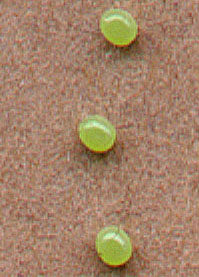 |
I offered the larvae apple, larch, rose and blueberry. Almost all the hatchlings
quickly moved to the blueberry, and I remembered my first encounter with a fifth instar poecilus
larva in a blueberry field in early July. I had taken some of the children out to rake
blueberries and uncovered the
brightly coloured larva at the edge of the field.
The third instar
larvae to the right
have not yet acquired the bulk or dramatic diagonal striping of the fourth and fifth instars.
Due to difficulties with sleeving or caging outdoor low growth blueberries, these larvae are
being reared indoors on cut food.
| 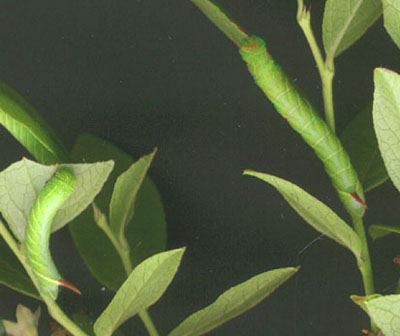 |
Larvae entered the fourth instar around July 8 and began consuming tremendous
amounts of food.
Striking colouration of diagonal lines and black peppering is now evident. |
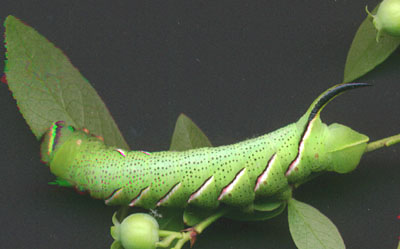 |
Droppings
also have an unusual and irregular shape, resembling short .22 calibre bullets with a tapered
tip and cylindrical shaft.
One of the larvae was considerably darker than the others and upon moving
into the fifth instar took on a
dramatic, deep purple colouration.
Sibling larvae remain green and are beginning to
bulk up
considerably for pupation by mid July. Now I can snack on
blueberries as I gather foliage.
|
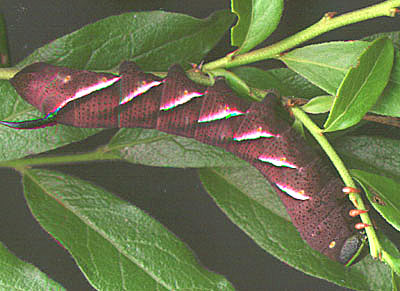 |
As larvae leave foliage
and begin to crawl around bottom of plastic containers,
they will be moved to buckets lined with paper towels and kept in a
dark, warm location.
Caterpillars of S. poecila reportedly feed on Apple (Malus),
sweetfern (Myrica), Carolina rose (Rosa carolina), blueberry and
huckleberry (Vaccinium), white spruce (Picea glauca), American larch
(Larix laricina), and alder (Alnus).
Larvae pupate readily in 4-5 days
under artificial conditions, i.e., a dark enclosure with loose paper
litter. I use a covered, five-gallon bucket loosely lined on the
bottom with three to four sheets of paper towels.
When larvae are about ready to pupate, i.e., they have
left foliage to descend tree branches or stems, I gently put them in
the buckets. I put as many as twenty larvae in a single pupation
bucket. | 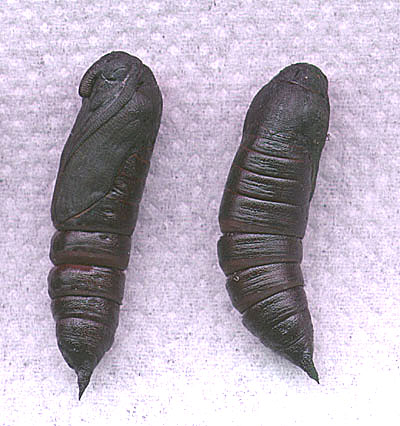 |
They should not be moved for a week or so to give the pupal shell
time to harden.
The first pupa was formed on July 22.
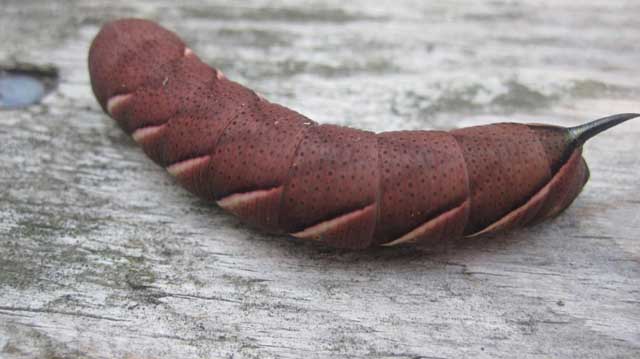
Sphinx poecila fifth instar, Orono, Penobscot County, Maine,
September 13, 2011, courtesy of Soren Sidell-Peterson via Anne Malena.
Return to Sphingidae Index
Return to Sphingini Tribe










